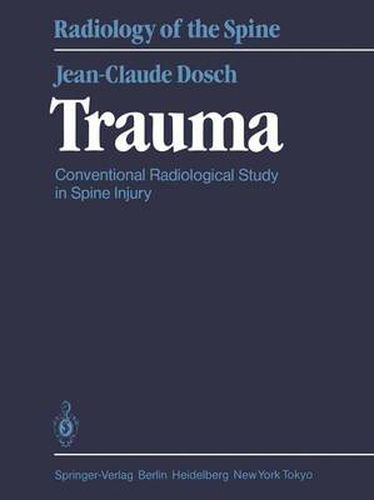Readings Newsletter
Become a Readings Member to make your shopping experience even easier.
Sign in or sign up for free!
You’re not far away from qualifying for FREE standard shipping within Australia
You’ve qualified for FREE standard shipping within Australia
The cart is loading…






This title is printed to order. This book may have been self-published. If so, we cannot guarantee the quality of the content. In the main most books will have gone through the editing process however some may not. We therefore suggest that you be aware of this before ordering this book. If in doubt check either the author or publisher’s details as we are unable to accept any returns unless they are faulty. Please contact us if you have any questions.
Progress in traumatology of the vertebral spine has been restrained for a long time by two hindering factors. The first obstacle is presented by the differences in approach and a conflict of competences. The neurosurgeons, considering only the spinal chord, have confined themselves to indications for laminectomy, an insufficient and usually ineffective intervention. The orthopedic surgeons, on the other hand, obsessed by the fear of medullary lesions, have long hesitated to apply the fundamental rules for the treatment of fractures, namely precise reduction followed by strict immobilization, thus depriving themselves of the efficacy of radiculomedul lar decompression and of the protection this procedure affords to these structures when they are themselves involved in the trauma. Taking these facts into account, together with the rather poor results of laminectomy, the specialists have wisely and successfully recommended that one should abstain from treating the initial lesion, but rather attenuate the damage by appropiate nursing care and adequate reeducation. The second hindering factor was the insufficient knowledge of the extreme complexity of the anatomic lesions. This explains the orthopedists’ relative caution; one only treats well what one knows well. More precise analysis of the lesions, not only of the bones but also of the joints, i. e., the osteofibrous involvement, is mainly based on strict radiologic semiology, which is rendered difficult because these structures are simultaneously affected. We are greatly indebted to Dr. DOSCH, radiologist at our Center, for having untertaken this difficult task, using all available conventional radiologic techniques.
$9.00 standard shipping within Australia
FREE standard shipping within Australia for orders over $100.00
Express & International shipping calculated at checkout
This title is printed to order. This book may have been self-published. If so, we cannot guarantee the quality of the content. In the main most books will have gone through the editing process however some may not. We therefore suggest that you be aware of this before ordering this book. If in doubt check either the author or publisher’s details as we are unable to accept any returns unless they are faulty. Please contact us if you have any questions.
Progress in traumatology of the vertebral spine has been restrained for a long time by two hindering factors. The first obstacle is presented by the differences in approach and a conflict of competences. The neurosurgeons, considering only the spinal chord, have confined themselves to indications for laminectomy, an insufficient and usually ineffective intervention. The orthopedic surgeons, on the other hand, obsessed by the fear of medullary lesions, have long hesitated to apply the fundamental rules for the treatment of fractures, namely precise reduction followed by strict immobilization, thus depriving themselves of the efficacy of radiculomedul lar decompression and of the protection this procedure affords to these structures when they are themselves involved in the trauma. Taking these facts into account, together with the rather poor results of laminectomy, the specialists have wisely and successfully recommended that one should abstain from treating the initial lesion, but rather attenuate the damage by appropiate nursing care and adequate reeducation. The second hindering factor was the insufficient knowledge of the extreme complexity of the anatomic lesions. This explains the orthopedists’ relative caution; one only treats well what one knows well. More precise analysis of the lesions, not only of the bones but also of the joints, i. e., the osteofibrous involvement, is mainly based on strict radiologic semiology, which is rendered difficult because these structures are simultaneously affected. We are greatly indebted to Dr. DOSCH, radiologist at our Center, for having untertaken this difficult task, using all available conventional radiologic techniques.